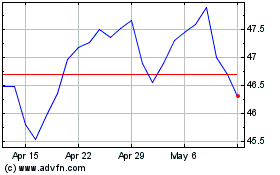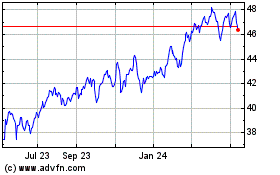The recent rumble on Wall Street coupled with looming fears over
rising interest rates has prompted many investors to re-examine
their portfolios. More specifically, investors who rely on the
current income stream from their portfolios have likely been
thinking of prudent ways to more favorably re-position their
holdings over the coming months. We recently had an opportunity to
talk with David Fabian, a managing partner at FMD Capital
Management, whose firm specializes in actively managed ETF
portfolios.
David offers his insights below on how investors can utilize
ETFs to build an income portfolio [see our List of ETF
Friendly Advisors]:
ETF Database (ETFdb): What are the key components of
a successful income portfolio?
David Fabian (DF): A successful income portfolio is made up
of multiple asset classes that include: dividend paying equities,
fixed-income, and alternative income strategies.
Most ETF income portfolios for retired or conservative investors
are centered on core holdings in bonds because of the dependable
dividends and reduced price swings. I tend to favor
actively-managed funds such as the PIMCO Total Return ETF (BOND)
which carries a wide array of treasury, mortgage, and corporate
debt of both developed and foreign nations. I like that active
managers have the ability to control their sector allocations,
duration, and credit profile to seek alpha. You can then
subsequently overweight your fixed-income exposure in tactical
sectors such as the iShares J.P. Morgan USD Emerging Markets Bond
ETF (EMB) or iShares iBoxx $ Investment Grade Corporate Bond ETF
(LQD) to enhance your returns [see also 101 High Yielding ETFs for
Every Dividend Investor].
 The dividend paying equity side of the
portfolio is designed to provide market correlation along with
inflation fighting effects over time. The Vanguard High Yield
Dividend ETF (VYM) is a favorite core holding that includes a broad
array of nearly 400 stocks with strong dividend histories. One of
the reasons I like this ETF is that it has an overweight allocation
to technology stocks such as Apple Inc (AAPL), which has become a
heavy weight in the dividend world and still offers excellent
growth potential.
The dividend paying equity side of the
portfolio is designed to provide market correlation along with
inflation fighting effects over time. The Vanguard High Yield
Dividend ETF (VYM) is a favorite core holding that includes a broad
array of nearly 400 stocks with strong dividend histories. One of
the reasons I like this ETF is that it has an overweight allocation
to technology stocks such as Apple Inc (AAPL), which has become a
heavy weight in the dividend world and still offers excellent
growth potential.
Lastly, the alternative sleeve of a successful ETF income
portfolio provides exposure to REITs, MLPs, and preferred stocks.
The Vanguard REIT ETF (VNQ) and iShares U.S. Preferred Stock ETF
(PFF) are two examples of alternative strategies that offer
above-average yields and access to non-traditional asset classes.
These are often overlooked by investors that are focused solely on
common stocks and bonds.
ETFdb: Why does diversification play such a key role in
this strategy?
DF: A diversified approach helps to minimize the risk of
being overly concentrated in one asset class, increase the overall
yield of the portfolio, and generally offers lower volatility.
By focusing exclusively on just one aspect of the
income-generating world, you put all your eggs in one basket, which
can lead to inconsistent returns. Conversely, spreading your money
among a variety of sectors and strategies allows your portfolio to
reap the benefits of non-correlated returns and steadier price
action.
Alternative assets in particular are one area that can offer
much higher yields and price trends that don’t directly correlate
with stocks or interest rates. This provides a counterweight to
your core equity and bond exposure, while still offering consistent
income streams.
ETFdb: With so many income-oriented ETFs available, how do
you decipher the best funds in each category?
DF: Dissecting the numerous ETFs available to income
investors can be a tedious task. However, it is made much simpler
with free tools from websites such as ETFdb.com to sort through the
various options [see Complete List of Dividend-focused
ETFs].
Below are some of the previously mentioned ETFs, and a few
others as well, along with their respective yield and year-to-date
returns (data as of 10/15/2014):
Ticker Name Yield YTD Return
|
| BOND |
PIMCO Total Return ETF |
2.89% |
5.98% |
| EMB |
iShares USD Emerging Markets Bond ETF |
4.51% |
8.20% |
| LQD |
iShares Invest Grade Corporate Bond ETF |
3.10% |
8.20% |
| VYM |
Vanguard High Yield Dividend ETF |
2.98% |
3.55% |
| HDV |
iShares High Dividend ETF |
3.45% |
5.38% |
| VNQ |
Vanguard REIT ETF |
3.93% |
18.23% |
| PFF |
iShares U.S. Preferred Stock |
5.75% |
11.56% |
| AMLP |
Alerian MLP ETF |
6.37% |
5.01% |
The number one factor when selecting an ETF that will have the
biggest impact on total return is the index construction
methodology. This includes examining the underlying securities,
sectors, and asset allocation to determine if they meet your
overarching criteria. Each ETF will offer a unique opportunity
based on its investment mandate.
I also encourage investors to pay close attention to fees – both
underlying expenses and transaction fees at their broker. Many
comparable ETFs offer widely varying fee structures, which can
significantly impact your long-term performance. One example of
this disparity is the 0.10% expense ratio charged by the Vanguard
REIT ETF (VNQ) and 0.45% expense ratio of the iShares U.S. Real
Estate ETF (IYR). Both indexes offer comparable exposure to a
diversified index of U.S.-listed REITs.
Volume and size are additional attributes to consider when
analyzing comparable funds. Small funds or those with insignificant
trading volume should be viewed with caution. I typically recommend
that investors select 2 – 4 funds in each of the three categories
to diversify their exposure [see also Dividend ETFs: 3 Things to
Consider].
 ETFdb: In the current environment, what is
your advice for income investors who are looking to achieve
above-average yield?
ETFdb: In the current environment, what is
your advice for income investors who are looking to achieve
above-average yield?
DF: The stretch for yield has been a theme on Wall Street
over the last several years as the Federal Reserve has fought to
keep interest rates low. However, many investors are still
languishing in areas that are offering yields below 3%.
To combat the low yield environment, investors can get creative
with their portfolio exposure and positioning. If they have a
higher tolerance for risk, this may include greater allocations to
the alternative asset sleeve of the portfolio or selecting bond
holdings that include high yield and emerging market coverage.
The one word of caution I have is that, in general, high yield =
high risk. Investors should assume that each incremental jump
higher in income will come with a commensurate higher level of risk
that includes price volatility. With the eventual tightening of
interest rates on the horizon, this will become an important theme
to manage moving forward.
ETFdb: How can active management play a role in an income
portfolio?
DF: In my opinion, active management continues to be a
significant driver of total return in the income investing world.
This is particularly true when you have to factor in credit cycles,
interest rate risk, and stock market returns. This will entail
casting a wide net in the search for suitable investment
opportunities with just the right mix of yield and risk to maintain
purchasing power and an eye towards capital preservation [see also
Monthly Dividend ETFdb Portfolio].
Sizing your allocations to each sleeve of the income portfolio
is also an important consideration. An interest rate tightening
cycle may call for lowering your allocation to bonds and increasing
exposure to stocks, alternatives, or cash to capitalize on more
advantageous prices in fixed-income down the road. Conversely, a
volatile stock market may increase the need for quality
fixed-income as a deflationary hedge.
The one commonality in this process is the use of low-cost,
diversified, and liquid ETFs to generate sustainable income with
consistent returns.
The Bottom Line
When it comes to generating a meaningful source of income,
especially in the current environment, dividend-focused ETFs may
offer creative solutions to yield-starved investors. With that
being said, simply going after the highest-yielding securities is a
surefire way to take on too much risk and leave your portfolio
quite vulnerable. Consider the advice featured above and be sure to
also do your own homework on any one fund before making an
allocation; it’s always better to take your time and uncover any
nuances before you’ve pulled the buy trigger.
Follow me on Twitter @SBojinov
[For more ETF analysis, make sure to sign up for our free ETF
newsletter]
Disclosure: No positions at time of writing.
Click here to read the original article on ETFdb.com.
Alerian MLP (AMEX:AMLP)
Historical Stock Chart
From Mar 2024 to Apr 2024

Alerian MLP (AMEX:AMLP)
Historical Stock Chart
From Apr 2023 to Apr 2024
